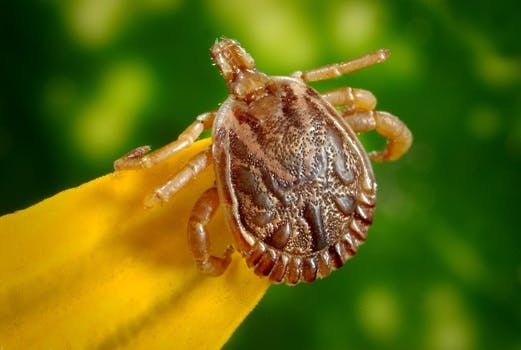HOW TO REMOVE TICKS FROM YOUR DOG AND THE BEST WAYS FOR KEEPING TICKS AWAY FROM YOUR DOG
Your Pooch has a flea or tick and your in a panic. Ticks and fleas are no fun to deal with for you or your dog and ticks can be very dangerous. Both ticks and fleas will make your dog very uncomfortable and it is even possible that they could catch a variety of diseases. The first protection is generally applying flea or tick medicine to your precious dog but even these applications can be dangerous is they are not handled carefully.
Prevention is the best advice so we suggest checking out some of these products to help prevent ticks and fleas.
Prevention is the best advice so we suggest checking out some of these products to help prevent ticks and fleas.
- Flea Control Pet Relief, Flea Tick Spray For Dogs, 100% Natural,! 30ml Safe Medicine For Fleas Dogs, Better Than Flea Collar Or Comb, Flea And Tick Prevention For Dogs, Made In USA
- Ultracide Flea and Tick IGR Can - 20 oz. FULL CASE
- Wondercide EcoTreat - Natural Outdoor Pest Control Concentrate - 1 gal
HOW TO REMOVE A DEADLY TICK FROM A DOG
If you see a tick on your dog then I suggest getting your dog to the vet immediately. Ticks are dangerous and can kill your dog if not removed correctly. In the case that your dog already has a tick and you need to remove it without a veterinarians help then there are a few things to be aware of.
- Firstly do not apply tick or flea medicine to remove it now as its too late. You will need to remove the tick first before applying any future tick and flea medicine as a preventative.
- Wear gloves or use something over your hands to protect your hands from coming into contact with the tick. Ticks carry a number of nasty diseases and you do not want to catch a disease from a tick on your dog.
- Get some tweezers to remove the tick as you are going to need to be very delicate and careful in its removal. Tweezers allow you to grab the tick at its lowest point and provide a good grasp so that you will not squash the ticks body.
- Put the tweezers as close to your dogs skin as possible. Be very careful not to pinch your dog or it will pull away and make it harder to remove the tick on subsequent attempts.
- If you can try and get someone else to hold and calm your dog so that you can concentrate on removing the tick correctly.
- Grasp the tick as low as possible and try and pull out straight with a very steady motion. You should expect that the tick will hold on hard but it will come away easily enough.
- Be very careful not to twist the tick, pull sharply or pull sideways. Pulling aggressively at the tick could break pieces off it and they could get stuck in your pooch. Also squashing the body of the tick can inject more tick venom into the dog and this can be quite dangerous. You do not want any of the tick to remain in the dogs skin. This can lead to infection.
- Crushing or squashing the tick can lead to more venom and inner tick fluid being injected into the dogs skin and you want to avoid this as much as possible.
- Place the tick in a glass jar and seal it tightly. Check the site for any more of the tick in case it broke. It is a good idea to check the rest of your dog for more ticks as sometimes they can pick up more than one on a walk especially in high grass or bushy areas.
- Take the tick and your dog to your vet as soon as possible. They will check the dog for signs of poison and check that you have removed the tick successfully. Take the jar with the tick to the vets and they can inspect the tick to see if you broke any parts of when removing the tick.
Ticks are dangerous and can kill. They are not something to be taken lightly.
WHAT TO DO AFTER REMOVING A TICK FROM A DOG?
The first thing to do is store the tick in a jar. You can add some isopropyl alcohol to kill the tick. Keeping the tick is useful for several reasons.
Firstly you can show the vet when you take your dog in to get checked and they can confirm that nothing broke off the tick.
 Secondly if your dog comes down with any odd symptoms in the next few weeks or months you will have the tick for the vet to do analysis on. This can help pinpoint any diseases which may be transmitted to your dog from the infected tick.
Secondly if your dog comes down with any odd symptoms in the next few weeks or months you will have the tick for the vet to do analysis on. This can help pinpoint any diseases which may be transmitted to your dog from the infected tick.
And if you forgot to wear gloves as we suggested it may be useful for your doctor if you come down with something from handling the tick.
Lastly don't forget to clean up. You should wash your hands and the tweezers thoroughly and use antibacterial cleansers. You should also use antiseptic cream on your dog if you have some. If not get some from your vet but its a good idea to have some around just in case of situations like this.
HOW TO PREVENT TICKS AND FLEAS ON YOUR DOG
Warmer weather can bring out the worst in ticks and fleas. For this reason spring and summer are usually going to be the worst time for outbreaks of ticks and fleas. But that doesn't mean ticks and fleas hibernate, they can appear at any time of the year and endanger your dog.Prevention is the best medicine for tick and flea control on your dog. There are many products which can be used for preventing ticks and flea infestations. There are topical treatments which you can apply to the back of your dogs neck, oral medications which are taken regularly which can cause the fleas and ticks to die when they bite your dog, dips, shampoos, collars and sprayers.
The most popular products are generally the topical ointments for the occasional outbreak but if you live in a tick and flea prone area then the oral medication is the best choice.
Talk to your Vet
Your local vet will be able to give you good advice on which tick and/or flea treatment to use. They will be able to give advice on how to clean your house or yard to clear out the source of the infestation.Another good reason to talk to your vet about flea and tick medicine is because some animals should not be given certain forms of the treatment or they may react badly. The main group of dogs which you should be careful when using a new tick or flea treatment include:
- Old dogs and elderly pets.
- Sick and ill animals. Ask your vet on any interactions with your flea or tick treatment and any other medication you may need to give to your dog.
- Young puppies as the dosage will need to be restricted.
- Pregnant dogs or dogs which are nursing puppies.
- Any dog which is on existing medication for another ailment. Your vet will be able to advise on this.
Precautions for Tick and Flea Treatments
These treatments are the same as any medicine which you would take yourself. It will have a clear set of instructions which you should read carefully. If you have any concerns on it talk to a vet.
Never use medicine intended for another animal on your dog. Especially different sizes of dogs as treatments will be made especially for a certain size dog. Also never use kitten or cat flea treatment on a dog as it can be very serious. If you have done this talk to your vet as soon as possible.
There are natural ointments which can be used to get rid of ticks and fleas but before using these you should consult your vet for advice.
Watch the dosage. Always given the prescribed dosage and never double up on treatments. Don't give your dog a topical treatment and then give it oral medication. Do not mix treatments or medicine as you can not be sure on the overall dosage you are giving your beloved pet.
If you are using an external treatment (spray, ointment, shampoo) then you should wear gloves when handling the flea and tick medicine and you should wash your exposed skin as soon as possible after applying the medicine.
Make sure you read the storage and disposal instructions. You do not want to leave it in a place that could poison a child or another animal.
Multiple pets can be an issue when trying to apply an external tick and flea treatment. You should keep the animals away from each other so that they can not lick the treatment off. You don't want them swallowing an external flea treatment or an external tick treatment as they are full of harmful chemicals when ingested.
You should always watch your dog carefully after you apply a treatment regardless if they have had the medication before. There is always the chance they could have an adverse reaction. If you notice something weird such as change in appetite, vomiting, diarrhea or excessive saliva then you should be on the phone to the vet as soon as possible to get a recommendation.
While tick and flea treatments and medicine can provide a massive relief for your pets it is still full of chemicals and are poisonous to the irritants. But treat them carefully and with respect and you shouldn't have a problem with ticks or fleas on your pet.
Other Sources of Information
Have you ever suffered from flea or tick infestations or has a tick made your dog sick?
Let us know what other advice you have found works by leaving a comment.
Why not read our advice on hiccups in dogs as there are some great and funny videos which are definitely worth seeing.


No comments:
Post a Comment